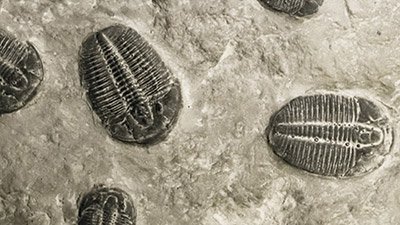
New Set of Oldest Footprints Found In Nevada
LiveScience: “Oldest ‘Footprints’ on Earth Found” They may not be much to look at, but the supposed oldest “footprints” are trampling over previous estimates of the age of animals.
Discovered on a rock in the U.S. state of Nevada, the footprints may not seem like much at first: two parallel rows of small dots, with each shallow dot a tiny two millimeters wide. But to scientists at the Ohio State University, they are all that remains of an ancient aquatic creature—possibly an ancestor of all modern animals.
That would be 30 million years earlier than what were the oldest known footprints.
According to Ohio State professor Loren Babcock, the creature was probably an arthropod resembling a centipede or a millipede. Based on the location of the footprints in the rock layer (which is allegedly right at the boundary between pre-Cambrian and Cambrian), Babcock and Ohio State doctoral student Soo-Yeun Ahn date the find to some 570 million years ago. That would be 30 million years earlier than what were the oldest known footprints, a fossilized trail in China dated to 540 million years ago.
The evolutionary significance of the new find is that it pushes back the earliest evidence for legged creatures into the pre-Cambrian, just before the “Cambrian explosion” wherein a great variety of life-forms “suddenly” appears in the Cambrian period of the fossil record. “At approximately 570 million years old, this new fossil not only provides the earliest suggestion of animals walking on legs, but it also shows that complex animals were alive on Earth before the Cambrian,” LiveScience reports.
The evolutionary claim, then, would possibly be that this discovery mutes the significance of the Cambrian explosion by showing that not all diversity appeared during the Cambrian period. The Cambrian explosion, which is sometimes used as evidence of creation, has baffled evolutionists and resulted in the development of the “punctuated equilibrium” model of evolution.
But does this really change anything? Evolutionists still have a sudden appearance of biodiversity far back in the fossil record, explicable only through the hotly contested concept of punctuated equilibrium. Creationists still understand the fossil record as, by and large, laid down by a single, global Flood, with different layers often indicating not time (or, at least, not millions of years of time), but different biological niches.
That said, Babcock noted, “I expect that there will be a lot of skepticism,” though he did not explicate why. A quick look at a photograph of the supposed “footprints” reveals why—and so perhaps all this fuss is unnecessary in the first place!
For more information:
Remember, if you see a news story that might merit some attention, let us know about it! (Note: if the story originates from the Associated Press, Fox News, MSNBC, the New York Times, or another major national media outlet, we will most likely have already heard about it.) And thanks to all of our readers who have submitted great news tips to us.
(Please note that links will take you directly to the source. Answers in Genesis is not responsible for content on the websites to which we refer. For more information, please see our Answers in Genesis Privacy Policy.)
Recommended Resources

Answers in Genesis is an apologetics ministry, dedicated to helping Christians defend their faith and proclaim the good news of Jesus Christ.
- Customer Service 800.778.3390
- Available Monday–Friday | 9 AM–5 PM ET
- © 2026 Answers in Genesis






